The SRAM Force eTap AXS and Shimano Ultegra Di2 (R8100) are arguably the most popular electronic groupset models. They sit in the mid-range, above the entry-level SRAM Rival eTap AXS and Shimano 105 Di2, and below the top-of-the-line Shimano Dura-Ace and SRAM Red AXS.
The Force eTap AXS and Ultegra Di2 inherit all the features of the Red eTap AXS and Dura-Ace groupsets but at a more affordable price.
Both groupsets have their advantages and disadvantages. In many cases, cyclists choose them based on personal preferences or, sometimes, availability.
Many key differences between the SRAM Force eTap AXS and Shimano Ultegra Di2 aren’t obvious. This article takes a closer look at all the features and specifications and breaks them down to help you decide the best fit for your needs.
Key takeaways
The 12-speed Shimano Ultegra Di2 and SRAM Force eTap AXS groupsets are mid/high-tiered electronic shifting groupsets for serious cyclists.
Both have all the features and functions of the top-of-the-line Dura-Ace Di2 and Red eTap AXS, but they are available at a much lower price range. The main difference is the materials used, hence a slightly heavier weight.
| Comparison | Shimano Ultegra Di2 | SRAM Force eTap AXS |
|---|---|---|
| Launched | September 2021 | April 2019 |
| Total weight | 2,800g to 2,900g | 2,500g to 2,900g |
| Shifting | Semi-wireless | Full wireless |
| Disc brakes | Yes | Yes |
| Rim brakes | Yes | Yes |
| Pricing | $2,400 to $2,500 | $2,400 to $2,500 |
Brake levers and shifters
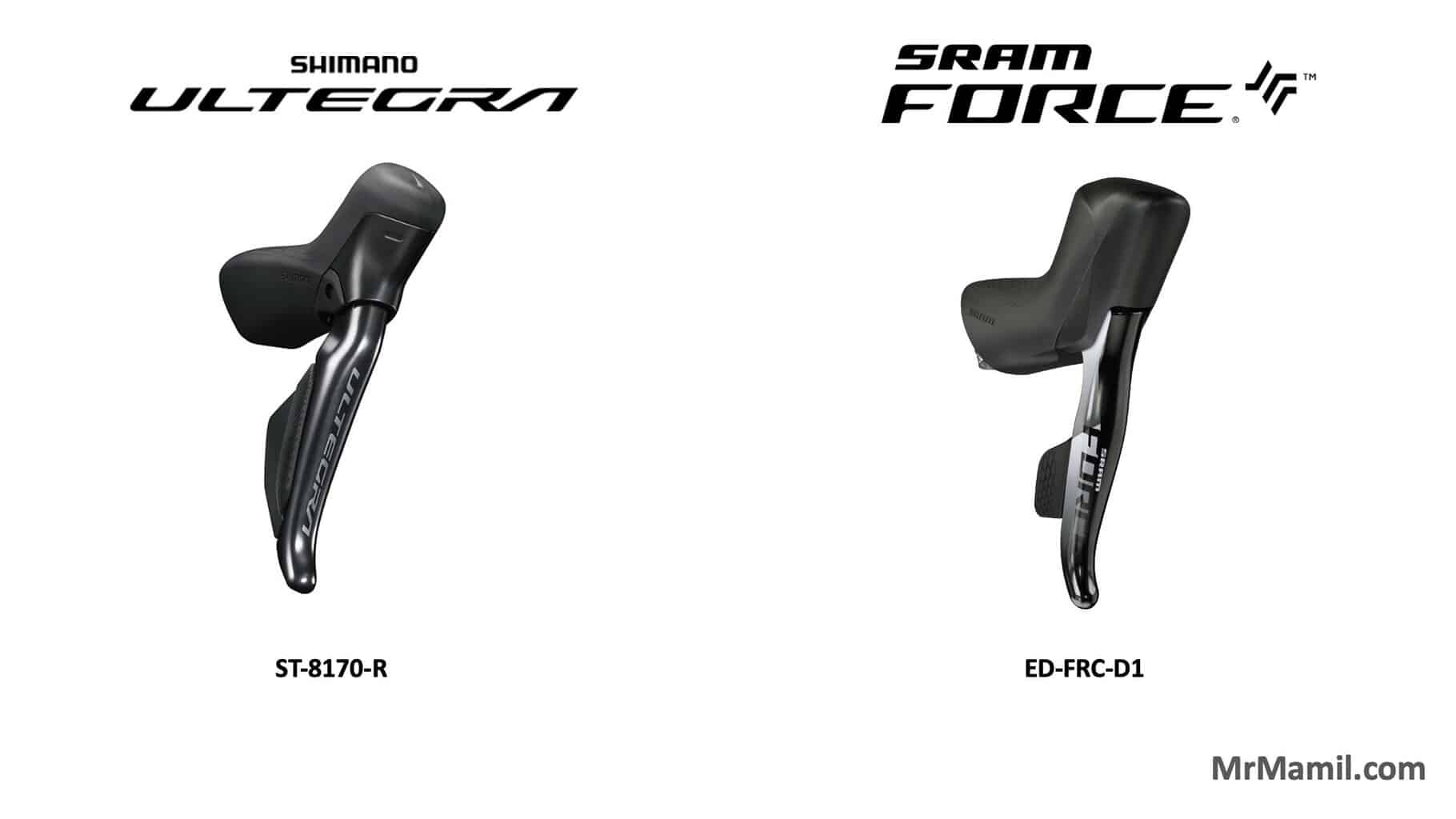
| Comparison | Shimano Ultegra Di2 | SRAM Force eTap AXS |
|---|---|---|
| Model no. | ST-R8170-R/L | ED-FRC-D1 |
| Disc brake | Available | Available |
| Rim brake | Available | Available |
| Batteries (each lever) | CR1632 | CR2032 |
| Lever material | Aluminum | Thermoplastic |
| Hood button | Yes | No |
| Cable ports | 2 | 1 |
| Brake caliper mount | Flat mount | Flat mount |
| Weight (each lever) | 379g | 414g |
| Price (USD) | $537 | $602 |
| Where to buy | Amazon Competitive Cyclist Wiggle | Amazon Competitive Cyclist Wiggle |
Shimano redesigned the Ultegra Di2 brake levers compared to its predecessor (R8070). The ServoWave technology, already available in GRX and XTR/XT range is now available on the Ultegra.
According to Shimano;
When you pull a ServoWave brake lever, initial pad travel is fast, so little lever movement is needed to bring the pads into contact with the rotor.
The power multiplication factor then increases rapidly at the pad-to-rim contact so more of the lever stroke is used to apply greater braking power with improved control.
Shimano ServoWave Technology
Each brake lever uses a CR1632 battery which Shimano claims lasts up to 2 years. There are two Di2 cable ports on each brake lever, but they’re not needed if it’s set up as wireless shifting.
The SRAM Force eTap AXS brake levers look slightly chunkier than the Shimano Ultegra Di2 levers. This has been the case from the 11s SRAM Red disc brake levers as SRAM uses a larger hydraulic master cylinder in the hoods.
Each brake lever uses a CR2032 battery which SRAM claims lasts up to 2 years, depending on the shifting frequency. The battery levels can be checked using the LED indicator via the SRAM AXS app.
Similarities
- Wireless shifting. Shimano Ultegra Di2 can be configured wireless (default option) or wired (requires additional cables and Junction A). SRAM Force eTap AXS is a fully wireless setup.
- Coin battery powered. Shimano Ultegra Di2 uses one CR1632 battery per lever, while SRAM Force eTap AXS uses a CR2032 battery.
- Cable ports. The Shimano Ultegra Di2 lever has two cable ports for a wired setup and sprint shifters. SRAM Force eTapAXS has a single cable port for Blips (SRAM).
- Lever reach adjustment refers to the distance between the drop bar grip to the brake lever. Shimano Ultegra Di2 and SRAM Force eTap AXS support it.
- Free stroke adjustment is available for both. This refers to the point in the brake levers’ stroke where the brake pads come into contact with the rotor. SRAM refers to this as the Contact Point Adjustment.
Differences
- Shift buttons. There are three shift buttons on the Shimano Ultegra Di2 levers compared to one on the SRAM Force eTap AXS. The buttons are fully customizable according to your preferences through the Shimano E-Tube App or SRAM AXS mobile app.
- Material. Shimano Ultegra Di2 brake levers are made of aluminum vs Long-fiber-reinforced thermoplastic (LFRT) for SRAM Force eTap AXS. The shifter buttons are made out of plastic.
- Weight. Shimano Ultegra is around 35g lighter (levers, brake caliper, brake hose).
- Tactile feel. The Shimano shift buttons feel lighter compared to the more tactile SRAM buttons.
Rear derailleurs (RD)
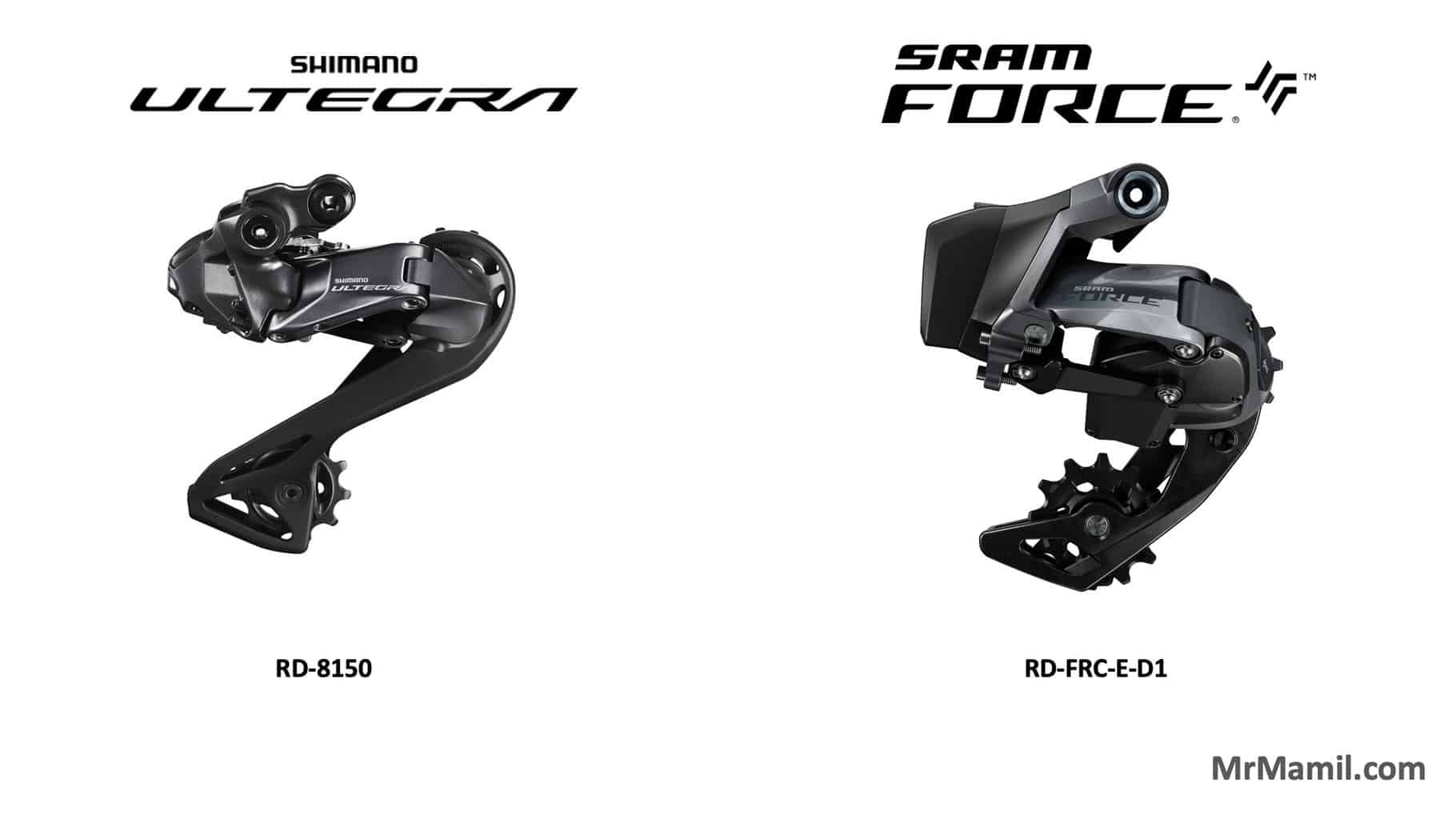
| Comparison | Shimano Ultegra Di2 | SRAM Force eTap AXS |
|---|---|---|
| Model no. | RD-R8150 | RD-FRC-E-D1 |
| Weight | 262g | 330g |
| Price (USD) | $410 | $648 |
| Max. cog size | 34T | 33T (short cage) 36T (medium cage) |
| Cage material | Aluminum | Aluminum |
| Pulley bearings | Steel | Steel |
| Where to buy | Competitive Cyclist Wiggle | Amazon Competitive Cyclist Wiggle |
The Shimano Ultegra Di2 rear derailleur sport the same design as the 105 Di2 and Dura-Ace Di2 models. It uses the Shimano Shadow design, which places the rear derailleur in a low-profile design that provides aerodynamic benefits and lessens the chances of damage in a crash.
The rear derailleur also acts as the hub of the Di2 system, holding the charging port, LED indicators, and function button for configurations. The aluminum derailleur cage supports cassette sizes up to 34T.
The SRAM Force eTap AXS rear derailleur is noticeably bigger as it needs to accommodate the battery. Two variants are available; short cage (max 33T) or medium cage (max 36T).
SRAM uses its Orbit technology (only available in Force and Red eTap AXS) to keep the chain under tension and ensure smooth shifting.
According to SRAM;
Orbit technology is an innovative new form of derailleur motion control. It utilizes silicon fluid as part of an elegant and ultra-lightweight damper system.
Compared to a standard friction clutch system, Orbit technology places no additional resistance on the rear derailleur’s spring when under slow or light movement. This means easier shifting and rear wheel removal. And while riding the fluid damper reduces chain bounce.
SRAM’s Orbit Technology
Similarities
- Long cage. The rear derailleurs are long cages with a maximum cog size of 34T (Shimano) and 36T (SRAM).
- Cage material. The rear derailleur cages are made from aluminum with steel pulley wheel bearings.
Differences
- 1X compatibility is supported by the SRAM.
- Weight. SRAM Force eTap AXS rear derailleur is significantly heavier (+68g) than Shimano Ultegra Di2. This is partly due to the SRAM battery, which weighs 26g alone.
More reading : How to Get the Most Out of Shimano Di2 Features
Front derailleurs (FD)
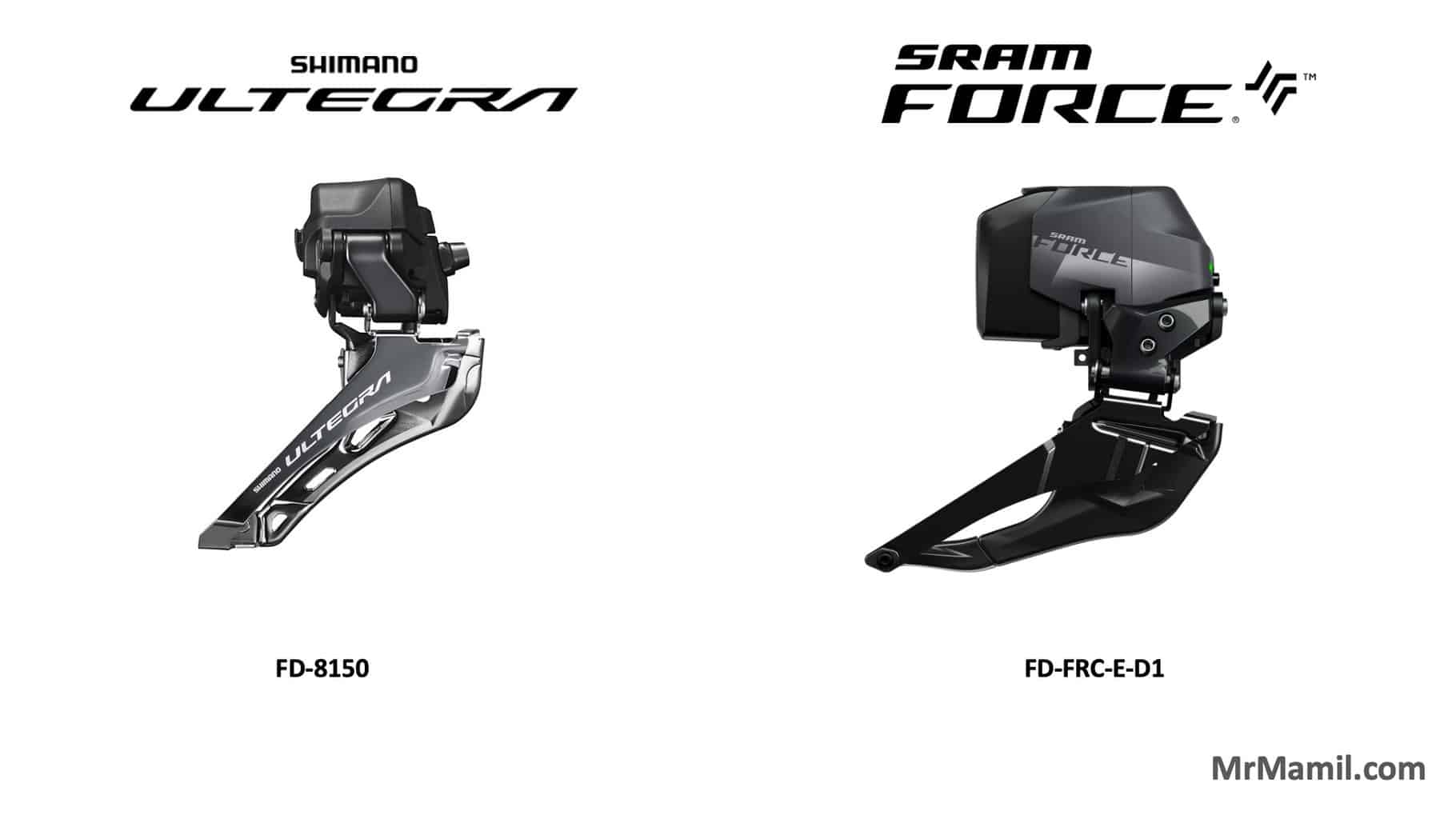
| Comparison | Shimano Ultegra Di2 | SRAM Force eTap AXS |
|---|---|---|
| Model no. | FD-R8150 | FD-FRC-E-D1 |
| Weight | 112g | 177g |
| Price (USD) | $260 | $418 |
| Where to buy | Competitive Cyclist Wiggle | Amazon Competitive Cyclist Wiggle |
Shimano has completely redesigned the Ultegra Di2 front derailleur to be lower profile and slimmer than its predecessor (R8070)
The SRAM Force eTap AXS front derailleur is bigger as it needs to accommodate the battery. It’s heavier (+55g) than the Shimano Ultegra Di2. This is partly due to the battery, which weighs 26g.
Shimano Ultegra vs SRAM Force cranksets
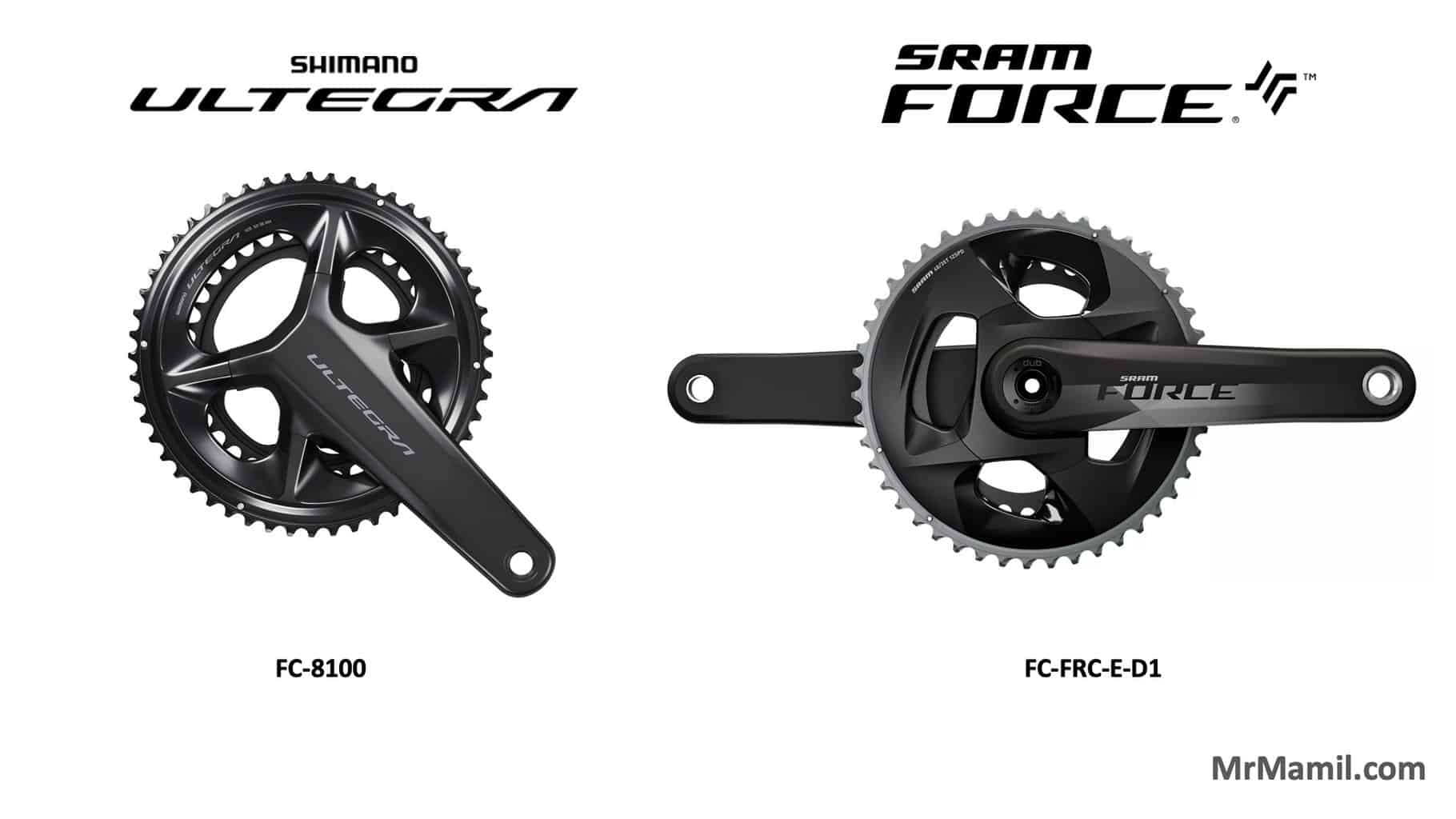
| Comparison | Shimano Ultegra Di2 | SRAM Force eTap AXS |
|---|---|---|
| Model no. | FC-R8100 | FC-FRC-D1 |
| Chainring options | 50-34T, 52-36T | 46/33T, 48/35T |
| BCD | 110mm | 107mm, Direct mount |
| Crankarm material | Aluminum | Carbon |
| Crankarm lengths | 160, 165, 170, 172.5, 175mm | 165, 167.5, 170, 172.5, 175, 177.5mm |
| Axle diameter | 24mm | 29mm |
| Chainline | 44.5mm | 45, 51mm (wide) |
| Powermeter | Optional | Optional |
| Weight | 700g (50/34) | 724g (46/33T) |
| Price (USD) | $315 | $461 |
| Where to buy | Amazon Competitive Cyclist | Amazon Competitive Cyclist Wiggle |
Shimano stuck with the traditional compact (50/34T) and semi-compact (52/36T) when they moved to 12s. However, a 53/39T (standard) chainring with the Ultegra 12s crankset is no longer there.
The Shimano 11s chainrings are incompatible with the 12s crankset, although they have the same BCD. The difference lies in the placement of the four arms. Compared to its predecessor, the Ultegra 12s crankarm is available from 160mm to 175mm.
SRAM employs the X-Range Gearing for all its 12s groupsets. The SRAM cranksets are available in 46/33T or 48/35T combinations.
There is a power meter upgrade variant for the SRAM. The chainrings and crankarms remain, while the 107mm BCD spider is swapped with the SRAM AXS power meter spider (PM-AXS-SPDR-D1).
Similarities
- Crankarm material. Both are made from aluminum.
- Power meter option. The SRAM crankset can be upgraded to a power meter by swapping the spider. For Shimano, a new crankset is required (FC-R8100P).
Differences
- Chainring combination. The Shimano Ultegra Di2 is available in 50/34T (compact) and 52-36T (semi-compact). The chainring sizes for SRAM are slightly smaller at 46/33T or 48/35T.
- BCD. Shimano uses a 110mm BCD, and SRAM uses a 107mm BCD. The SRAM crankset also supports a Direct Mount chainring to lower the overall weight.
- Bottom bracket compatibility. Shimano crankset uses a 24mm steel axle. SRAM uses a 29mm steel axle and is only compatible with SRAM DUB bottom brackets.
- Crankarm lengths. Shimano crankarms are available in 160, 165, 170, 172.5, and 175mm lengths. SRAM is available from 165 to 175mm, in 2.5mm increments.
More reading : How to Decide Between Compact vs Standard Crankset
Groupsets comparison
Shimano vs SRAM gear ratios
One of the biggest differences between the Shimano and SRAM 12-speed groupset is the gear ratios.
SRAM’s X-Range Gearing has a wider gearing range and tighter jumps between cogs than Shimano. This makes maintaining the same cadence more versatile and easier after a gear shift.
- High gear. SRAM has the highest gear ratio at 4.8 using a 48/35T front chainring and 10T rear cog, followed by Shimano (4.73) with a 52/36T front chainring and an 11T rear cog.
- Low gear. SRAM has the lowest gear ratio at 0.92 using a 46/33T front chainring and 36T rear cog. The lowest gear ratio for Shimano is 1.00 with 50/34T front chainring and 34T rear cog.
The table below shows the possible gearing setup for Shimano and SRAM.
| Front chainring | Rear cog | Shimano gear ratio | SRAM gear ratio |
|---|---|---|---|
| 50 | 11 | 4.55 | |
| 34 | 36 | 0.94 | |
| 52 | 11 | 4.73 | |
| 36 | 36 | 1.00 | |
| 46 | 10 | 4.60 | |
| 33 | 30 | 1.10 | |
| 33 | 36 | 0.92 | |
| 48 | 10 | 4.80 | |
| 35 | 30 | 1.17 | |
| 35 | 36 | 0.97 | |
| 50 | 11 | 4.55 | |
| 34 | 34 | 1.00 | |
| 52 | 11 | 4.73 | |
| 36 | 34 | 1.06 |
Shimano Ultegra vs SRAM Force chains
| Comparison | Shimano Ultegra Di2 | SRAM Force eTap AXS |
|---|---|---|
| Model | CN-M8100 | CN-FRC-D1 |
| Links | 116, 126 | 114, 120 |
| Weight | 254g | 259g |
| Material | Steel | Steel |
| Outer plates finish | Gray | Nickel |
| Inner plates finish | Chrome | Chrome |
| Pin design | Solid | Solid |
| Price (USD) | $46 | $50 |
| Where to buy | Amazon Competitive Cyclist Wiggle | Amazon |
Shimano Ultegra and SRAM Force eTap AXS chains are steel and have a solid pin design.
The Shimano Ultegra chains are available in 116 and 126 links. It’s the same chain as the Shimano XT mountain bike range.
The SRAM Force chains are available in 114 and 120 links. They have a nickel outer and chrome inner plate finish. It uses a Flattop design which, according to SRAM, is quieter and more durable.
According to SRAM;
To gain a wider gear range with smaller gearing steps, the chain has to get narrower. With Flattop, we’ve added material on the flat side of the chain plates to strengthen every link.
Flattop chains feature longer wearing large diameter rollers that help deliver the same drivetrain efficiency as our 11-speed drivetrains. All of these technologies together have enabled us to engineer a narrower 12-speed chain that lasts 36% longer than our 11-speed chains.
SRAM
More reading : When to Replace A Bike Chain?
Cassettes
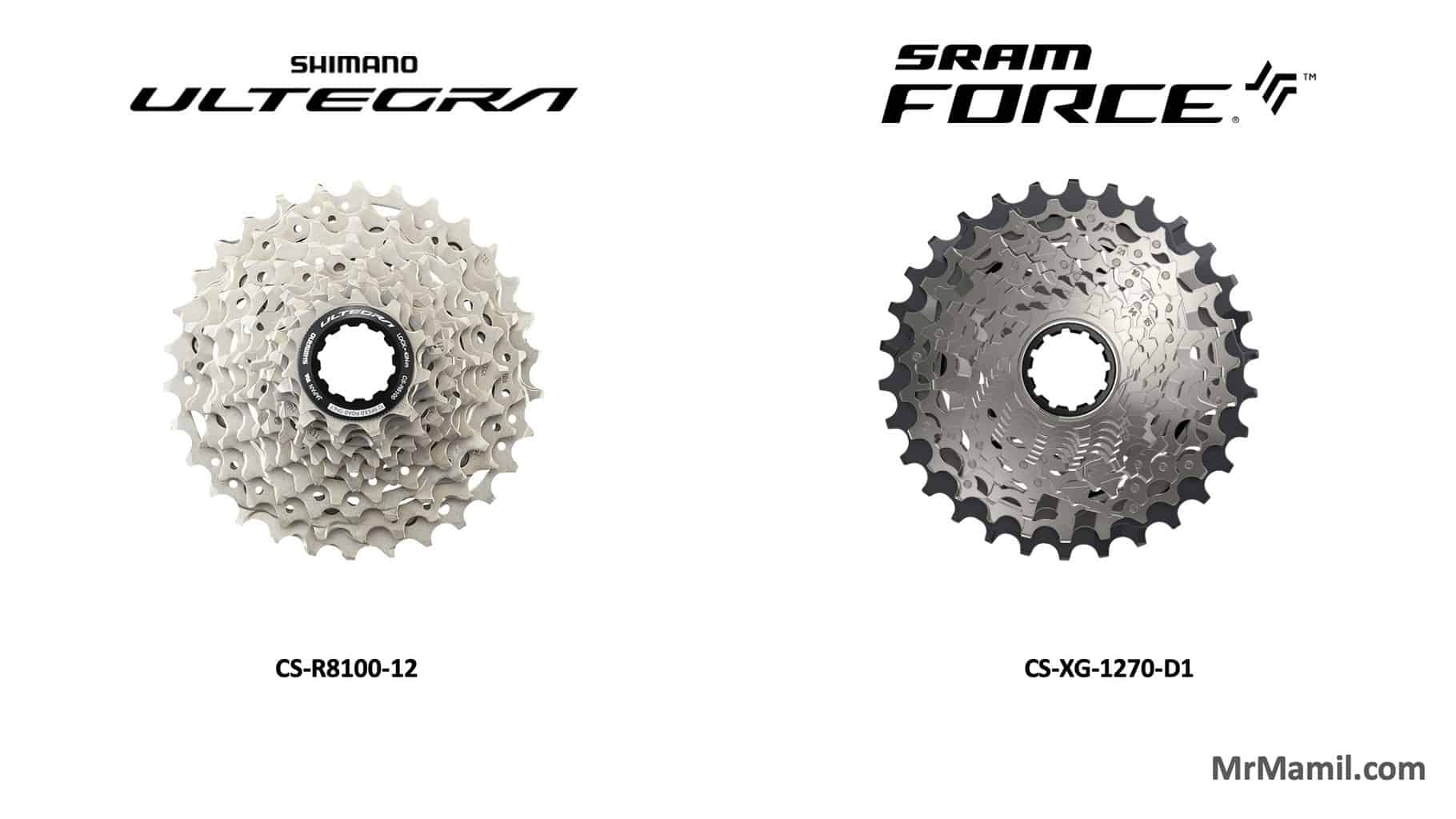
| Comparison | Shimano Ultegra Di2 | SRAM Force eTap AXS |
|---|---|---|
| Model | CS-R8100-12 | CS-XG-1270-D1 |
| Sizes | 11-30T (291g) 11-34T (345g) | 10-28T (222g) 10-30T (236g) 10-33T (266g) 10-36T (310g) |
| Price | $112 | $195 |
| Where to buy | Amazon Competitive Cyclist Wiggle | Amazon Competitive Cyclist |
The Shimano Ultegra 12-speed cassette is available in two sizes; 11-30T and 11-34T. It uses the newer Hyperglide+ (HG+) technology, where the tooth profile matches the chain for faster shifting, up and down the cassette, especially under load.
SRAM cassettes are available in four sizes; 10-28T, 10-30T, 10-33T, and 10-36T. This caters to both serious cyclists, racers, and also everyday cyclists.
The cassette is a single piece, with four cogs CNC machined out of a single block of steel and eight individually pinned cogs. SRAM cassettes before 2021 have a black finish compared to nickel-chrome.
More reading : Shimano 105 vs Ultegra vs Dura-Ace Cassettes
Disc brake rotors
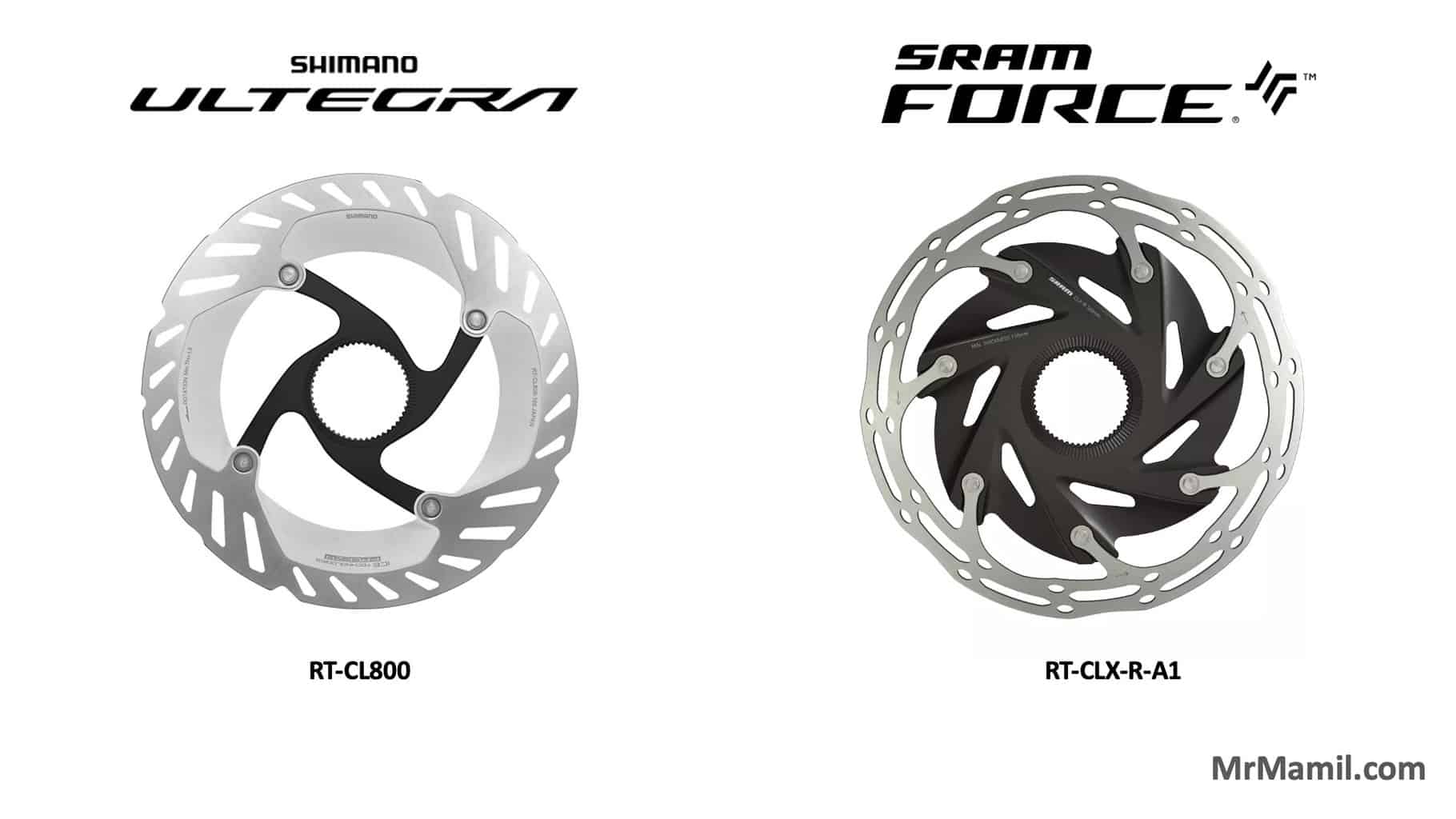
| Comparison | Shimano Ultegra | SRAM Paceline | SRAM Centerline |
|---|---|---|---|
| Model no. | RT-CL800 | RT-PLN-A1 | RT-CLX-R-A1 |
| Mount type | Centerlock | Centerlock, 6-bolt | Centerlock, 6-bolt |
| Weight (140mm) | 95g | 137g | 108g |
| Weight (160mm) | 113g | 157g | 135g |
| Price (USD) | $61 | $54 | $113 |
| Where to buy | Amazon Competitive Cyclist | Amazon Wiggle | Amazon Competitive Cyclist Wiggle |
Shimano Ultegra and SRAM Force rotors are available in 140mm and 160mm sizes.
SRAM offers two rotor choices;
- Paceline. Cheaper but heavier.
- Centerline. Lighter but 2x more expensive.
Both Paceline and Centerline rotors are available in either Centerlock or 6-bolt. Shimano rotors are only Centerlock.
Shimano used the same brake rotors from their mountain bike lineup, the RT-MT800, when launching the 12-speed Ultegra groupset in September 2021. In June 2022, Shimano introduced a new disc rotor, the RT-CL800, as part of the Ultegra R8100 series.
More reading : Centerlock vs 6-bolt Disc Brake Rotors
Disc brake pads
The Shimano Ultegra comes with Shimano’s latest, fifth-generation organic (resin) brake pads, L05A-RF. Older models such as L03A-RF (organic), L02A-RF (organic), or L04C-MF (metallic) are compatible with the disc brake calipers as they all have the same shape.
The SRAM Force AXS comes with an organic brake pad with steel plating. There are other alternatives, such as organic compounds with aluminum plating or metallic compounds with steel plating.
More reading : Resin vs Metal Disc Brake Pads Comparison
Batteries
Shimano introduced a new battery (BT-DN300) for the 12-speed wireless groupsets. There are three ports on the battery, with only two needed for a wireless setup. The third port will be used for a wired setup to connect the shifters via a junction box.
The weighs 52g and has a capacity of 500 mAh. It takes 1.5 to 2 hours for a full charge and lasts for around 2,500 to 3,000km per charge.
SRAM uses one battery each for the front and rear derailleurs. Each battery weighs 24g and can last up to 1,000km per charge for the rear battery, which sees more usage.
The advantage of SRAM is that the batteries are easily interchangeable should any battery run flat. It takes around 60 minutes for a full charge.
More reading : How to Check Shimano Di2 Battery Levels

Alex Lee is the founder and editor-at-large of Mr. Mamil. Coming from a professional engineering background, he breaks down technical cycling nuances into an easy-to-understand and digestible format here.
He has been riding road bikes actively for the past 12 years and started racing competitively in the senior category during the summer recently.